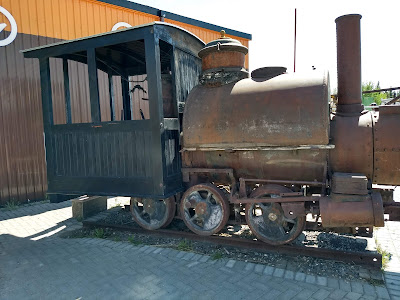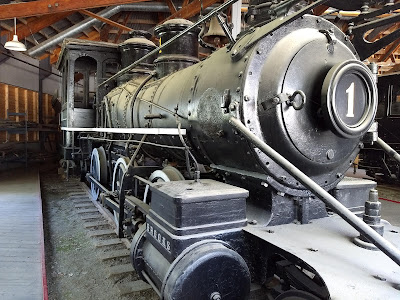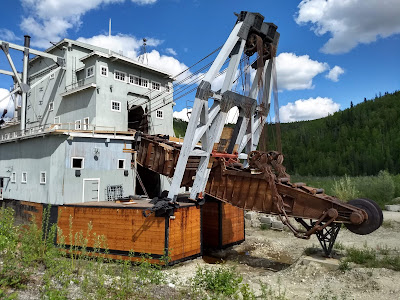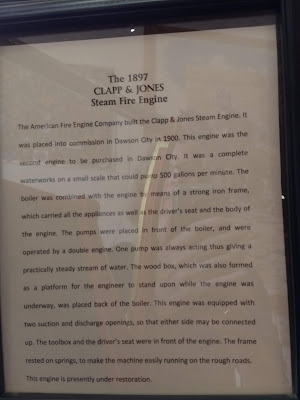Carcross, Yukon - Skagway, Alaska - Whitehorse, Yukon - Pelly Crossing, Yukon - Dawson City, Yukon
May 24 - 31, 2019
This is going to be long because we've seen a lot in the last week and I haven't had time to do a blog.
On Friday, May 24 we did a day trip to Skagway, Alaska. Here are some pictures of the drive from Carcross to Skagway.
First a little Klondike gold rush history. In August 1896 gold was found on Rabbit Creek, now named Bonanza Creek. The country was in a depression and many were left destitute, so when the word got out that there was gold to be found people started heading to Dawson City. It was 1898 before most of them got to Dyea or Skagway, Alaska. Dyea was the first town 'built'. The prospectors had to have one ton of goods to get into Canada, enough to keep them for a year (for which they were taxed at the Canadian border). Here's a list of what was required (remember, you can click on the pictures to enlarge them).
After they got everything on the list they had to get it over the mountain on the Chilkoot Trail. Here's a picture of the camp below and the men going up the trail. If they got out of line it might be hours before someone would let them back in.
Over 30,000 went on this 33 mile trail, but it would have taken much longer because they had to get their ton of goods over the top, requiring several trips. Going over in the winter was actually better because when all the ice thawed (they carved steps into the ice going up the trail) everything turned to mud. Eventually they built a tram to take the supplies up to the top of the mountain but it wasn't cheap. When they got to the end of the trail they reached Bennett Lake.
Soon Skagway was found to be a better port, and the White Pass, although 10 miles longer than the Chilkoot Trail, was less steep and was wide enough for pack animals. (Eventually a railroad was built from Skagway to Whitehorse, but it wasn't finished until July 1900, and by that time most of the gold was gone.) In the winter of 1898 they camped by Bennett Lake and made rafts, waiting for the lake to thaw. Finally on May 29 they started out. In the next few days five men died and the rapids near Whitehorse on the Yukon River crushed 150 boats. After that it was much easier going down the river until they got to Dawson City. Unfortunately, gold was found in 1896, and by the time the stampeders arrived in 1898 prospectors in the region had long since staked claims and made their fortunes. Many of the 'cheechakos' didn't even bother to try looking for gold and instead sold their gear and supplies for steamboat fare back down to Whitehorse. Eventually most of the gold that could be found by individuals was found, and commercial mining companies bought the claims and brought in the big dredging machines (more about that later).
We arrived in Skagway, did some shopping, and went to Liarsville for a salmon bake, show, and gold panning.
Liarsville is so named because when the press got to Skagway and found out how hard it was to go up the Chilkoot Pass or the White Pass they decided to set up camp outside of Skagway and report their 'first hand accounts' of the search for gold 500 miles away in Dawson City. The reality was that there weren't gold nuggets laying around waiting to be picked up. Seems like 'fake news' was in vogue then too. Here are some shots of what their camp would have looked like.
We drove back into town and took a walking tour, bought a few souvenirs, and drove a few miles away to where the town of Dyea was. Although it was once a bustling town there isn't anything left of it except woods and a cemetery.
On the way back to Skagway we stopped at an overlook and took pictures.
You can see a couple of cruise ships in port.
While the drive to Skagway was beautiful the drive back was even better. So many pretty views.
On Saturday, May 25 we drove to Whitehorse and stayed at the Hi Country RV Park. We had site #60 which had a nice little area outside the door. However, it was right next to the highway and quite noisy.
Sunday we toured the S.S. Klondike II, the sternwheeler that ran freight and silver lead ore between Whitehorse and Dawson City along the Yukon. In the 1950s the highway between Whitehorse and Dawson City was built, so the sternwheeler was no longer needed. It was converted into a cruise ship but was shut down due to lack of interest in 1955. It sat at the shipyard and was eventually donated to Parks Canada where it was gradually restored. In 1966 it was moved to its present site, requiring 3 bulldozers, eight tons of Palmolive soap, a crew of 12 men, and three weeks. Greased log rollers eased the process.
Also on Sunday we went through the Transportation Museum.
This plane is actually the world's largest weather vane. It groans and creaks when it moves but it's fun to watch.
Although the museum is at the airport it had all kinds of transportation exhibits. Here are a few.
One story that intrigued me was the story of Helen Klaben and Ralph Flores. In February 1963 they were flying from Dawson Creek to California in a single engine plane when it crashed near the BC/Yukon border. They spent 49 days in the woods before they were rescued.
On Monday, May 27 we started up the Klondike Highway and stopped at Pelly River Crossing Campground on the river. It looks like it used to be a provincial park but was abandoned. The locals sort of take care of it now, but I saw pictures of it two years ago and it's much worse today. Too bad because it could be very nice. Oh well, it was free.
On Tuesday, May 28 we continued on the Klondike Highway to Dawson City, Yukon. It rained a little and by the time we got to Bonanza Creek the back of the 5th wheel was even worse than ever. It's hard to see out the window.
On Wednesday, May 29 we went to the Visitors Center and then to the Dawson City Museum.
They have a railway museum attached so had a guided tour of that first. It was interesting to hear the history of the trains, some quite short in years because they weren't suited for the area.
They were very dusty so I asked why they didn't clean them. Our tour guide said that they have to have a specialist do it, and until they had the roof repaired there wasn't much point.
From there we went and toured Dredge No. 4. There were only the four of us so we basically had a private tour.
It was owned by commercial mining companies, who had the money to operate the large dredges. This storyboard shows how the dredge works.
Here are the ore buckets that were on the dredge.
The machinery on the inside was huge. They really built things to last back then.
This is a trommel, which is a screening machine with different sized holes used to separate materials.
From the trommel the material would go to the sluice box, where there was fabric, coconut fiber, and a mat to collect the gold.
From there the tailings were conveyed out the back of the dredge.
As you can imagine, this whole process was very noisy and the men's hearing wasn't very good after they worked there for a while.
A view from the main control room.
There is still gold being mined in the area, mostly from small operators. As you can see, there is also still gold being found.
From there we went to the site near where the gold was first found. I say near because the creeks have moved many times so none of them are in the place they were when the gold was first found.
In the winter they would heat up the frozen ground and dig vertically and horizontally to get 'pay dirt'. Then in the summer when the creeks thawed they would process the dirt for gold. It wasn't glamorous work for sure.
We went to the Dome Mountain Overlook. You can get an almost 360 degree view.
In the fall and winter the northern lights can be seen from there. But we won't be seeing any northern lights because sunset isn't until after midnight here and even then it doesn't get really dark.
On Thursday we went on a walking tour of part of Dawson City. Many of the buildings have been restored or are in the process. There are a few that may be beyond repair. Here are some pictures of the city.
That was part of the walking tour and we decided to do a driving tour later for the rest of it. It was time for the S.S. Keno tour, which also turned out to be a private tour. There aren't many tourists here this time of year.
Michael read "Call of the Wild" and "White Fang" so I got a picture of Jack London's cabin.
We've decided to go on the Top of the World Highway Sunday and wanted a preview of the ferry ride across the Yukon River and the road. It was pretty weird to not see anything but water in front of Bill's truck.
On the way back to the campground we saw a Firefighter's Museum and stopped. These steam fire engines were actually used in Dawson City. The first one has been restored and is beautiful.
Friday, May 31 and Saturday, June 1 it's supposed to rain, although we haven't had much, so we're staying in. I think we've seen everything we want to see and it's nice to rest. Sunday we'll be...
Roving on...
The heavens declare
the glory of God, and the firmament shows His handiwork. Psalm 19:1














































































































